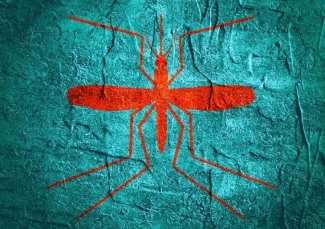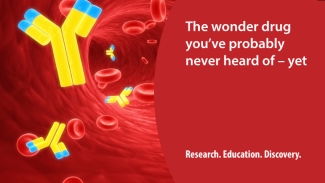Hijacked! Research reveals the takeover of blood platelets by dengue virus
Wednesday, March 09, 2016 Dr. Geraldine Walsh
"The ever-present need for innovative ways to combat dengue and other emerging viruses and pathogens has never been clearer."
New research from our Centre for Innovation Scientist Dr. Ed Pryzdial in Vancouver, BC, has revealed for the first time that dengue — the most common virus spread by insects — hijacks blood platelets and commandeers the machinery inside the platelet to reproduce infectious virus. This previously unknown mechanism helps researchers better understand how dengue virus works, and helps blood operators recognize the possible risk this infectious agent poses to blood safety.
As anyone who’s read the news recently knows, the world of emerging viral infections is fast-paced and rapidly changing. Canadian Blood Services is constantly vigilant of the potential risks to blood safety posed by "emerging" viruses — that is new viruses or known viruses whose range or incidence is increasing. One such threat comes from dengue virus. Endemic in many tropical and subtropical regions, like its close cousins West Nile virus and Zika virus, dengue is typically transmitted through the bite of Aedes mosquitoes.

What do blood operators worldwide need to know about dengue?
Dr. Pryzdial explains,
"There are several reasons why dengue is considered a potential infectious risk to blood supplies. Once an individual is infected, there’s a three- to 14-day window period before symptoms appear. On top of that, about 50 per cent of people infected with dengue never develop symptoms, despite having high levels of virus in their blood. So blood for transfusion could be collected from a donor who is infected with the virus but is not displaying symptoms. Each year, there are about 200 million of these people around the world."
Dengue infection can be serious. For infected individuals who do display symptoms, they range from a mild flu-like illness to a rare severe hemorrhagic fever that can be fatal.
Very little was known about dengue virus and its interactions with blood components before the recent studies from Dr. Pryzdial’s laboratory, based at the Centre for Blood Research at the University of British Columbia. Dr. Pryzdial and his team’s initial study looking at dengue, which was published in the journal Blood last year, provided the first evidence that dengue virus binds to, enters, and hijacks blood platelets. (See illustration of model of dengue virus binding and replication by platelets.)
Like all viruses, dengue needs another living organism — a host — in order to reproduce and survive. All viruses have similar modus operandi - they enter the host’s cells and use the cell’s internal machinery to replicate their own genetic material (in the case of dengue, single-stranded RNA). New viruses are then released from the infected cell, continuing the cycle of infectivity. However, the finding that dengue uses platelets to replicate was unprecedented:
Blood platelets do not have a nucleus, the part of the cell where genetic material and much of the machinery to replicate that material is found. So in the past, platelets have not really been considered a cell in which viruses could replicate. In recent years it’s been discovered that platelets can do part of the job. They can convert RNA to protein. Now in this study, we show for the first time that dengue virus enters platelets and uses this machinery to replicate its RNA-based genome and to synthesize viral proteins to begin its life-cycle.
Importantly, this study showed that live, infectious dengue virus offspring are produced by infected platelets, and that this can happen at both body temperature (37°C) and at room temperature (25°C), which is the temperature at which platelets are stored in the blood bank.
A follow-up study looking at dengue in both platelet and red blood cell components under blood bank storage conditions revealed more. Published in the journal Transfusion in early 2016, this study showed that even at low levels of virus that mimic those expected in an asymptomatic donor, infectious dengue virus can replicate both in platelet and red blood cell components stored under standard blood bank storage conditions. For more information on both dengue studies from Dr. Pryzdial’s laboratory, read January 2016's research unit.
These findings indicate that blood donor systems may be vulnerable to dengue virus, a particular concern in tropical and subtropical regions where dengue is endemic. If a blood donation from an infected individual were collected, the virus would likely persist in the fresh components produced from that blood, and could possibly be transmitted to the transfusion recipient. One positive finding though was that the rate of virus production in stored blood components does not offset the overall rate of virus decay. This means components that have been stored for longer contain less infectious dengue virus.
Worldwide, there have been just five documented cases of dengue transmission by blood transfusion, and all of these have occurred in areas where dengue is present or endemic.
What does this mean here in Canada? Are there risks to the Canadian blood supply?
In reality, the risk to the Canadian blood supply is exceptionally low. Due to the Canadian climate, the dengue virus and the Aedes mosquito that carry it are not found in Canada. A Canadian who travels to a dengue endemic region could possibly become infected. However, current donor deferrals for travel to areas with malaria mean that that person would not be eligible to donate blood for a period upon their return to Canada. Due to this deferral period it is highly unlikely that blood would be collected from a donor infected with dengue virus in Canada. Also, while this research shows that dengue can persist in fresh blood components like platelets and red blood cells, much of the plasma collected in Canada undergoes additional processing to make plasma-derived protein products. This processing kills all viruses making these products completely safe.
Although the risk in Canada is extremely low, as author Stephen King once said, "there's no harm in hoping for the best as long as you're prepared for the worst." Knowing that the virus can survive and replicate in fresh blood components helps all blood operators to better understand the risks posed by dengue. It helps our organization choose appropriate donor deferrals for travel to regions in which dengue and other viral risks are endemic, and it helps determine where to focus future research efforts. Pathogen inactivation — a blood safety approach that destroys all viruses in blood components and is used in many parts of the world — is a research focus at Canadian Blood Services, with numerous studies underway assessing its safety and effectiveness.

Dr. Pryzdial’s research group investigates the regulation of clot formation (coagulation), including the effects of viruses and how clots dissolve (fibrinolysis); the molecular basis of clotting protein deficiency in patients; and the quality of clotting constituents in blood products.
Canadian Blood Services – Driving world-class innovation
Through discovery, development and applied research, Canadian Blood Services drives world-class innovation in blood transfusion, cellular therapy and transplantation—bringing clarity and insight to an increasingly complex healthcare future. Our dedicated research team and extended network of partners engage in exploratory and applied research to create new knowledge, inform and enhance best practices, contribute to the development of new services and technologies, and build capacity through training and collaboration.
The opinions reflected in this post are those of the author and do not necessarily reflect the opinions of Canadian Blood Services.
Related blog posts
A research, education. and discovery blog Did you know that we do research? Quite a lot of it, in fact. Last year, our research teams, working in our labs across Canada, published 250+ scientific papers in peer-reviewed journals and presented 200+ posters or talks at major national and international...
Wonder drug it may be, but IVIg is a slippery fish. Even after 60 years, little is known about precisely how it works. An encounter with a scientist The first thing you notice when you walk into Dr. Don Branch’s office at 67 College Street in Toronto is how small it seems. And colourful, owing to an...
Led by Dr. Sandra Ramirez, a development scientist at Canadian Blood Services’ Centre for Innovation, this research project led to a new standard that will reduce the number of discarded red blood cell units. By Jenny Ryan and Patrick Walton The issue Since the 1970s, blood operators have limited...


